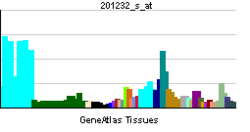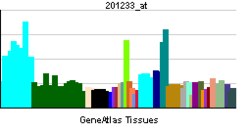PSMD13
26S proteasome non-ATPase regulatory subunit 13 is an enzyme that in humans is encoded by the PSMD13 gene.[1][2]
The 26S proteasome is a multicatalytic proteinase complex with a highly ordered structure composed of 2 complexes, a 20S core and a 19S regulator. The 20S core is composed of 4 rings of 28 non-identical subunits; 2 rings are composed of 7 alpha subunits and 2 rings are composed of 7 beta subunits. The 19S regulator is composed of a base, which contains 6 ATPase subunits and 2 non-ATPase subunits, and a lid, which contains up to 10 non-ATPase subunits. Proteasomes are distributed throughout eukaryotic cells at a high concentration and cleave peptides in an ATP/ubiquitin-dependent process in a non-lysosomal pathway. An essential function of a modified proteasome, the immunoproteasome, is the processing of class I MHC peptides. This gene encodes a non-ATPase subunit of the 19S regulator. Two transcripts encoding different isoforms have been described.[3]
Interactions
PSMD13 has been shown to interact with PSMC4[4] and PSMD6.[4]
References
- ↑ Hori T, Kato S, Saeki M, DeMartino GN, Slaughter CA, Takeuchi J, Toh-e A, Tanaka K (Oct 1998). "cDNA cloning and functional analysis of p28 (Nas6p) and p40.5 (Nas7p), two novel regulatory subunits of the 26S proteasome". Gene 216 (1): 113–22. doi:10.1016/S0378-1119(98)00309-6. PMID 9714768.
- ↑ Coux O, Tanaka K, Goldberg AL (Nov 1996). "Structure and functions of the 20S and 26S proteasomes". Annu Rev Biochem 65 (1): 801–47. doi:10.1146/annurev.bi.65.070196.004101. PMID 8811196.
- ↑ "Entrez Gene: PSMD13 proteasome (prosome, macropain) 26S subunit, non-ATPase, 13".
- ↑ 4.0 4.1 Ewing, Rob M; Chu Peter, Elisma Fred, Li Hongyan, Taylor Paul, Climie Shane, McBroom-Cerajewski Linda, Robinson Mark D, O'Connor Liam, Li Michael, Taylor Rod, Dharsee Moyez, Ho Yuen, Heilbut Adrian, Moore Lynda, Zhang Shudong, Ornatsky Olga, Bukhman Yury V, Ethier Martin, Sheng Yinglun, Vasilescu Julian, Abu-Farha Mohamed, Lambert Jean-Philippe, Duewel Henry S, Stewart Ian I, Kuehl Bonnie, Hogue Kelly, Colwill Karen, Gladwish Katharine, Muskat Brenda, Kinach Robert, Adams Sally-Lin, Moran Michael F, Morin Gregg B, Topaloglou Thodoros, Figeys Daniel (2007). "Large-scale mapping of human protein-protein interactions by mass spectrometry". Mol. Syst. Biol. (England) 3 (1): 89. doi:10.1038/msb4100134. PMC 1847948. PMID 17353931.
Further reading
- Goff SP (2003). "Death by deamination: a novel host restriction system for HIV-1.". Cell 114 (3): 281–3. doi:10.1016/S0092-8674(03)00602-0. PMID 12914693.
- Maruyama K, Sugano S (1994). "Oligo-capping: a simple method to replace the cap structure of eukaryotic mRNAs with oligoribonucleotides.". Gene 138 (1-2): 171–4. doi:10.1016/0378-1119(94)90802-8. PMID 8125298.
- Seeger M, Ferrell K, Frank R, Dubiel W (1997). "HIV-1 tat inhibits the 20 S proteasome and its 11 S regulator-mediated activation.". J. Biol. Chem. 272 (13): 8145–8. doi:10.1074/jbc.272.13.8145. PMID 9079628.
- Suzuki Y, Yoshitomo-Nakagawa K, Maruyama K et al. (1997). "Construction and characterization of a full length-enriched and a 5'-end-enriched cDNA library.". Gene 200 (1-2): 149–56. doi:10.1016/S0378-1119(97)00411-3. PMID 9373149.
- Madani N, Kabat D (1998). "An endogenous inhibitor of human immunodeficiency virus in human lymphocytes is overcome by the viral Vif protein.". J. Virol. 72 (12): 10251–5. PMC 110608. PMID 9811770.
- Simon JH, Gaddis NC, Fouchier RA, Malim MH (1998). "Evidence for a newly discovered cellular anti-HIV-1 phenotype.". Nat. Med. 4 (12): 1397–400. doi:10.1038/3987. PMID 9846577.
- Hoffman L, Gorbea C, Rechsteiner M (1999). "Identification, molecular cloning, and characterization of subunit 11 of the human 26S proteasome.". FEBS Lett. 449 (1): 88–92. doi:10.1016/S0014-5793(99)00403-2. PMID 10225435.
- Roperch JP, Lethrone F, Prieur S et al. (1999). "SIAH-1 promotes apoptosis and tumor suppression through a network involving the regulation of protein folding, unfolding, and trafficking: identification of common effectors with p53 and p21(Waf1).". Proc. Natl. Acad. Sci. U.S.A. 96 (14): 8070–3. doi:10.1073/pnas.96.14.8070. PMC 22189. PMID 10393949.
- Mulder LC, Muesing MA (2000). "Degradation of HIV-1 integrase by the N-end rule pathway.". J. Biol. Chem. 275 (38): 29749–53. doi:10.1074/jbc.M004670200. PMID 10893419.
- Zhang QH, Ye M, Wu XY et al. (2001). "Cloning and functional analysis of cDNAs with open reading frames for 300 previously undefined genes expressed in CD34+ hematopoietic stem/progenitor cells.". Genome Res. 10 (10): 1546–60. doi:10.1101/gr.140200. PMC 310934. PMID 11042152.
- Sheehy AM, Gaddis NC, Choi JD, Malim MH (2002). "Isolation of a human gene that inhibits HIV-1 infection and is suppressed by the viral Vif protein.". Nature 418 (6898): 646–50. doi:10.1038/nature00939. PMID 12167863.
- Huang X, Seifert U, Salzmann U et al. (2002). "The RTP site shared by the HIV-1 Tat protein and the 11S regulator subunit alpha is crucial for their effects on proteasome function including antigen processing.". J. Mol. Biol. 323 (4): 771–82. doi:10.1016/S0022-2836(02)00998-1. PMID 12419264.
- Strausberg RL, Feingold EA, Grouse LH et al. (2003). "Generation and initial analysis of more than 15,000 full-length human and mouse cDNA sequences.". Proc. Natl. Acad. Sci. U.S.A. 99 (26): 16899–903. doi:10.1073/pnas.242603899. PMC 139241. PMID 12477932.
- Gaddis NC, Chertova E, Sheehy AM et al. (2003). "Comprehensive investigation of the molecular defect in vif-deficient human immunodeficiency virus type 1 virions.". J. Virol. 77 (10): 5810–20. doi:10.1128/JVI.77.10.5810-5820.2003. PMC 154025. PMID 12719574.
- Lecossier D, Bouchonnet F, Clavel F, Hance AJ (2003). "Hypermutation of HIV-1 DNA in the absence of the Vif protein.". Science 300 (5622): 1112. doi:10.1126/science.1083338. PMID 12750511.
- Zhang H, Yang B, Pomerantz RJ et al. (2003). "The cytidine deaminase CEM15 induces hypermutation in newly synthesized HIV-1 DNA.". Nature 424 (6944): 94–8. doi:10.1038/nature01707. PMC 1350966. PMID 12808465.
- Mangeat B, Turelli P, Caron G et al. (2003). "Broad antiretroviral defence by human APOBEC3G through lethal editing of nascent reverse transcripts.". Nature 424 (6944): 99–103. doi:10.1038/nature01709. PMID 12808466.

